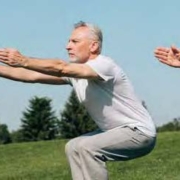The Importance of the Hamstring Muscles

by Paula Allia PT, DHSc, MTC, OCS
The hamstring muscles are the muscles that are located on the posterior aspect of the upper leg. There are three of them (semimembranosus, semitendinosus, and biceps femoris). Two of the muscles are on the medial posterior thigh and one to the lateral aspect of the thigh.
The muscles taper and the tendons associated with these muscles attach down below to the knee.
Muscles have the potential to act on the joints that they crossover and attach. All three hamstring muscles attach proximally to the ischial tuberosity which is up on the pelvis and travel down to attach below the knees. Thus, the hamstrings contract to extendthe hip proximally. Distally contraction of these muscles flexes(bends) the knee. The two most medial hamstrings also can cause medial rotation of the tibia in the lower leg.
All muscles are affected by the flexibility and extensibility that are present. Because these are two joint muscles, the angle of one joint will have an effect on the action at the other joint it crosses. Proximally, the hamstrings attach at the lower part of the pelvis. In pilates these are referred to as the sit bones. Because of this attachment, the position of the pelvis can alter the length of these muscles. For example, if one or more hamstrings are shortened, they may pull on the pelvis. This may cause the pelvis to rotate posteriorly. If this occurs, the low back may flatten some and be vulnerable to injury.
Proper tension of the hamstring group helps to stabilize the low back by supporting the ligament that attaches from the sacral bone (triangular bone at the base of the spine) and the pelvis.
If the abdominal muscles are weak the pelvis may fall into an anterior tilt. This position will tighten the hamstrings. The most lateral hamstring, the biceps femoris, lies above the sciatic nerve so addressing this muscle and others (piriformis) is necessary in a thorough evaluation.
Tightness here may cause pressure to the sciatic nerve. The hamstrings distally flex the knee. These muscles help to control the bone in the lower leg (tibia) from moving excessively forward. This control works with the anterior cruciate ligament (ACL). Thus, strong hamstrings are important with this ligamentous injury.
All of the above are extremely important in regard to the hamstrings and their involvement in supporting the bony framework of the low back and leg. It can be confusing but understand that:
- Hamstrings have direct action at the hip, pelvis, and knee.
- Tight hamstrings can contribute to a flatter back.
- Proper strength and flexibility allow for appropriate support to the joint they cross.
- Tight hamstrings can contribute to low back, hip and knee dysfunction and pain.
- Tight hamstrings can cause the quadriceps in the front of the knee to have to work harder to straighten the knee.
- Weak hamstrings can decrease the support to the ACL.
- If the medial hamstrings are tight versus the biceps femoris, excess medial rotation can occur and contribute to knee dysfunction.
- Stretching the hamstrings holding and anterior tilt will stretch them more. Strengthening the hamstrings can be done with exercises that flex the knee and extend the hip.
It is fair to say that the muscles should be stimulated and strengthened throughout the entire excursion of the muscles. This will help to ensure that there will be no specific areas of vulnerability.
Stretching is a key component to keeping the hamstrings healthy. A quick slip with a leg going forward as in slipping on ice or sliding on a tennis or pickleball court can cause a sudden stretch that could tear the muscle or tendon if there is too much tightness and limitation.
There are various ways to stretch and strengthen the hamstring to keep the body most prepared for any activity. Seek out the right people to guide you as proper execution will keep you healthy and safe from injury in most instances.
Here’s To Your Health!
Find that professional that understands the body fully and help to guide you to your longevity in activities. Exercise smart and undo excessive strains. For further information, please call Fitness Together in downtown Naples at (239) 263-9348.




Leave a Reply
Want to join the discussion?Feel free to contribute!